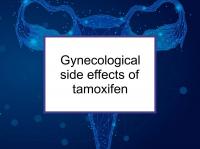Tamoxifen is a type of endocrine treatment (or hormone therapy) used to prevent and treat estrogen receptor positive (ER+) breast cancer. It is prescribed for both women and for men with breast cancer. Tamoxifen interferes with a tumor's ability to use estrogen rather than blocking its production within the body like aromatase inhibitors.
Some of the side effects of tamoxifen are caused by estrogen deprivation, others are specific to separate actions of the drug. Since tamoxifen is life-saving, with proven effectiveness in preventing ER+ breast cancer and its recurrence, every effect should be made to complete treatment as prescribed.
This webpage is designed to outline common gynecological side effects of tamoxifen. Side effects may be easier to tolerate if they are known to be typical. Knowledge of possible side effects can also encourage tamoxifen users to seek medical help, if needed. The risk of one of the most serious potential sides effect of tamoxifen, endometrial or uterine cancer, can be influenced by diet, according to available evidence.
See also the following tamoxifen-related pages:
Tamoxifen and endometrial (uterine) cancer
Tamoxifen can stimulate endometrial tissue growth and adverse cellular transformation, increasing the likelihood of postmenopausal bleeding, endometrial polyps, and endometrial (uterine) cancer. Symptoms of uterine cancer include bloody vaginal discharge, spotting, a persistent odorless clear or milky discharge, atypical pelvic pain or pressure, and pain during intercourse not due to vaginal dryness.
Rate of endometrial cancer among tamoxifen users
The risk of endometrial cancer among tamoxifen users has been estimated at 1.5% to 1.9% for five years of treatment (compared to 0.3% to 0.6% for non-users), with higher risk for longer treatment periods. One 2021 study reported that the rate of endometrial cancer per 1,000 person-years was 0.62 for age under 40, 0.82 for ages 40 to 49, 1.13 for ages 50 to 59, and 1.45 for over 60. In other words, the risk of developing endometrial cancer as a result of tamoxifen treatment increases with age.
More than one-third of women who develop endometrial cancer do so one year or longer after finishing tamoxifen treatment, according to another study. This suggests that endometrial cancer surveillance should continue after completion of treatment.
Foods that reduce the risk of endometrial cancer
The following foods (or major components) can protect against endometrial cancer while not interfering with tamoxifen's effectiveness:
Please read the applicable food webpages when making your own food lists since these pages contain important advice, food rankings (e.g., highly recommended, recommended in moderation), consumption limits, and other pertinent information.
One 2021 study reported that use of metformin to treat type 2 diabetes was associated with reduced mortality in women with endometrial cancer.
Foods that increase the risk of endometrial cancer
The foods and supplements listed below have been associated with increased risk of endometrial cancer. Sweets and other foods with high glycemic index, as well as animal fats, have been shown to increase the risk. Foods with high acrylamide content, such as French fries, cereal, potato chips, potatoes, and baked goods, have also been shown to increase risk of endometrial cancer. In addition, exposure to cadmium is associated with increased risk.
Long-term electric blanket use has also been found to be associated with increased risk of endometrial cancer and should be avoided.
Tamoxifen and menopause
As noted above, tamoxifen can be taken before and after menopause. Many women who are still menstruating start tamoxifen during perimenopause, when they are in the process of transitioning to menopause and are beginning to experience menopausal symptoms. Tamoxifen itself does not cause menopause (the cessation of ovulation). In fact, tamoxifen is sometimes used to induce ovulation to treat infertility. However, the estrogen deprivation caused by tamoxifen typically results in menopausal symptoms such as hot flashes. (On a positive note, tamoxifen-caused menopausal symptoms have been found to be associated with lower risk of breast cancer recurrence).
Tamoxifen users should not use combined hormone replacement therapy (estrogen plus progestin HRT), including bioidentical hormones, to relieve menopausal symptoms, since this could increase the risk of relapse of ER+ breast cancer.
Premenopausal women whose periods stop as a result of taking tamoxifen (and not as part of the natural transition from perimenopause to menopause) appear to have higher risk of endometrial cancer. Women who experience postmenopausal bleeding during or after stopping tamoxifen should seek medical evaluation and surveillance.
Tamoxifen and menstrual periods
Tamoxifen can cause heavy menstrual periods (with associated light to severe cramps), irregular periods, light periods with spotting, or a cessation of periods (amenorrhea). Generally speaking, all of these patterns fall within the range of normal reactions to tamoxifen treatment. However, as noted above, women whose periods stop as a result of taking tamoxifen appear to be at higher risk of endometrial cancer. Severe pelvic pain could be the result of tamoxifen-induced endometriosis, endometrial cancer or other medical conditions. Very heavy bleeding should also be evaluated. The bottom line is that women should expect possible changes in their menstrual cycle as a result of taking tamoxifen, but seek medical evaluation and possible treatment for any severe or concerning menstrual symptoms.
Tamoxifen and vaginal health
The estrogen deprivation caused by tamoxifen can cause vaginal dryness. Some women also experience recurrent yeast infections and vaginal discharges of various types. Both should be medically evaluated and treated to the extent possible.
Tamoxifen, contraception and pregnancy
Becoming pregnant is possible during tamoxifen treatment, but not recommended since it has been found to result in birth defects in a minority of the babies born. Such a pregnancy also interferes with breast cancer treatment (since tamoxifen is normally stopped if the pregnancy is allowed to proceed) and exposes any remaining cancer cells to pregnancy hormones. Tamoxifen treatment alone usually does not appear to compromise future reproductive potential. Women on tamoxifen are normally advised to use barrier contraception methods or the levonorgestrel intrauterine system (which might reduce the risk of endometrial cancer).
